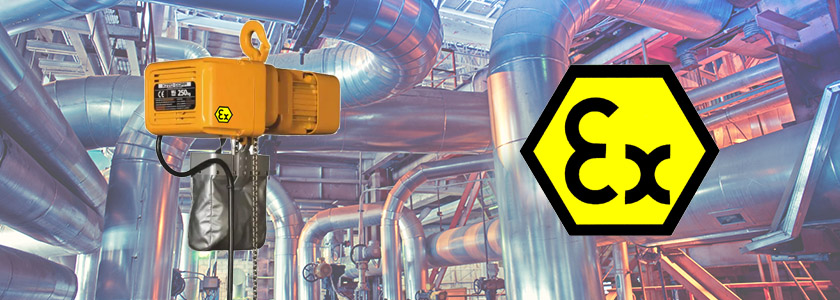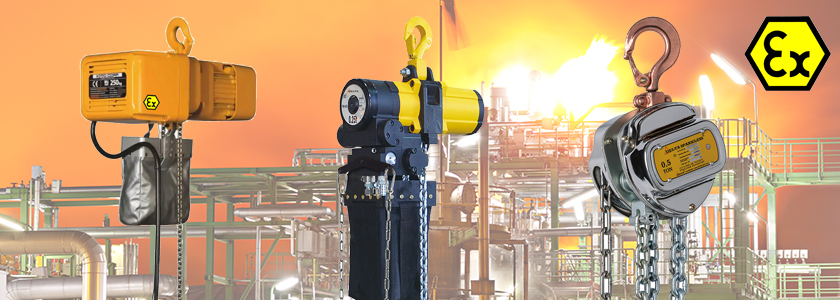Whether at the movies or over your head on New Year’s Eve, explosions are always fun to watch. They’re a little less fun to be a part of, however. Unfortunately, some workplace situations provide all the necessary ingredients for combustion – all that’s required is a spark to get things started.
ATEX hoists, also called explosion-proof hoists, are designed to ensure that this combustion never happens, and that workers can safely do their job when they are working in potentially dangerous environments.
What are ATEX hoists?
ATEX refers to a European Union directive on equipment standards. It takes its name from the French “Atmosphères Explosibles”, or “Explosive Atmospheres”: air, usually in a confined space, that is at risk of explosion due to the presence of flammable gases, vapours or dust.
The ATEX directive is designed to ensure equipment used in such environments, like explosion-proof electric chain hoists, won’t initiate combustion from a hot surface or an unintentional spark being exposed to the dangerous air. In New Zealand, such equipment is often referred to as “intrinsically safe”.
There are two primary ATEX directives, but the one that applies specifically to equipment is ATEX 95 (Directive 2014/34/EU), which sets the minimum requirements that manufacturers must meet to market and sell their products in the EU.
Rather than create our own rules, in New Zealand we instead use ATEX and International Electrotechnical Commission (IEC) standards for explosion-proof electric hoists and other such equipment.
Key features of ATEX hoists
How does an ATEX hoist differ from a non-ATEX hoist? Here are the key features to look out for.
Certification, classification and compliance
ATEX-certified hoists comply with the ATEX directive and are marked with the appropriate certification code. But not all explosion-proof hoists are made the same: they will be further classified based on the concentration of explosive substances that they can handle, and how long they can be used in certain atmospheres. Finally, the hoist may need to comply with other relevant standards, such as IECEx.
Temperature ratings
ATEX hoists are designed to operate within certain temperature ranges to minimise the risk of ignition. The temperature class of an explosion-proof or flame-proof hoist defines the maximum surface temperature that the hoist can reach during operation.
Construction
Explosion-proof hoists are designed from the ground up to avoid exposed electrical sparking, and are constructed with materials that reduce the risk of overheating. They often include design elements such as flame-proof enclosures, grounding features and intrinsically safe electrical components.
Inspection and maintenance
Explosion-proof chain blocks and hoists must be regularly inspected and maintained according to the manufacturer’s instructions if they are to continue to offer the required protection. This process includes checking componentry, ensuring proper grounding and fixing any potential issues as soon as they’re identified.
Helping New Zealand manufacturers safely solve their lifting challenges with the best local and global solutions
Worker safety must be the number one priority for any Kiwi business, even more so for organisations that work in potentially dangerous environments.
Choosing ATEX-compliant equipment isn’t an everyday task, so in order to select the correct explosion-proof hoist, you need to consult with experts who deal in these products all day every day, who know the rules and regulations inside and out, and who can ensure that your workers are kept safe.
At Stratalign we’ve spent years helping Kiwi businesses identify and secure the lifting equipment they need for any situation. We have the knowledge and expertise you need to identify the hoist that will keep your workers safe while making your business more efficient and productive.



